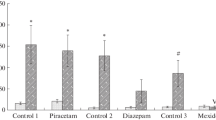Abstract
Rats were placed in a conventional shuttle-box and submitted to buzzers and shocks presented in random sequence and with no temporal association. These rats made pseudoconditioned barrier-crossing responses to the buzzer. The performance of these responses was enhanced by metrazol and trimethadione, depressed by amobarbital, phenobarbital, meprobamate, diazepam, chlorpromazine and reserpine, and unaffected by diphenylhidantoin, cannabidiol, caffeine, strychnine, picrotoxin and dibenamine. The enhancing effect of trimethadione, but not that of metrazol, was antagonized by dibenamine. With the exception of metrazol, chlorpromazine and reserpine, the drug effects on pseudoconditioning reported here do not correlate with those reported for pre-trial administration on conditioned avoidance, using the same doses and route of administration (intraperitoneal). The present results support the notion that pseudoconditioning is a distinct behavioral entity with pharmacologic characteristics clearly different from those of avoidance conditioning.
Similar content being viewed by others
References
Anisman, H., Waller, T. G.: Effects of inescapable shock on subsequent avoidance performance: role of response repertoire changes. Behav. Biol. 9, 331–355 (1973)
Bignami, G., de Acetis, L., Gatti, G. L.: Facilitation and impairment of avoidance responding by phenobarbital sodium, chlordiazepoxide and diazepam—the role of performance base lines. J. Pharmacol. exp. Ther. 176, 725–732 (1971)
Bliss, C. I.: Statistics in Biology, Vol. 1, pp. 243–257. New York: McGraw-Hill 1967
Cook, L., Kelleher, R. T.: Effects of drugs on behavior. Ann. Rev. Pharmacol. 3, 205–222 (1963)
Cook, L., Weidley, E.: Behavioral effects of some psychopharmacological agents. Ann. N.Y. Acad. Sci. 66, 740–752 (1957)
Evangelista, A. M., Depiante, R.: Efecto del ambiente posterior a la prueba sobre consolidación de memoria. Symp. on Central Nerv. Syst. and Behavior, Soc. Latinoamer. Psicobiol., abstracts, p. 14 (1971)
Evangelista, A. M., Gattoni, R. C., Izquierdo, I.: Effect of amphetamine, nicotine and hexamethonium on performance of a conditioned response during acquisition and retention trials. Pharmacology 3, 91–96 (1970)
Evangelista, A. M., Izquierdo, I.: The effect of pre- and posttrial amphetamine injections on avoidance responses of rats. Psychopharmacologia (Berl.) 20, 42–47 (1971)
Evangelista, A. M., Izquierdo, I.: Effects of atropine on avoidance conditioning. Psychopharmacologia (Berl.) 27, 241–248 (1972)
Fulginiti, S.: Participación de mecanismos adrenérgicos en el aprendizaje y en la acción de drogas que lo facilitan. Doctor's Thesis, School of Chemistry, University of Cordoba 1972
Gattoni, R. C., Izquierdo, I.: Post-trial time-course of the effect of conditioning and pseudoconditioning on hippocampal and neocortical RNA. Ciencia e Cult. (Sao Paulo) 26, 169–171 (1974a)
Gattoni, R. C., Izquierdo, I.: The effect of conditioning and pseudoconditioning on RNA metabolism in rat hippocampus and neocortex. Behav. Biol. (in press) (1974b)
Grether, W. F.: Pseudo-conditioning without paired stimulation encountered in attempted backward conditioning. J. comp. Psychol. 25, 91–96 (1938)
Innes, I. R., Nickerson, M.: Drugs acting on postganglionic adrenergic nerve endings and structures innervated by them (sympathomimetic drugs). In: The pharmacological basis of therapeutics, L. S. Goodman and A. Gilman, Eds., pp. 478–523. London: MacMillan 1970
Izquierdo, I.: Mecanismos adrenérgicos y colinérgicos periféricos en el pseudocondicionamiento. Proc. 6th Ann. meet. Soc. Argent. Framacol. Exp., abstract No. 16 (1973)
Izquierdo, I.: Possible peripheral adrenergic and cholinergic mechanisms in pseudoconditioning. Psychopharmacologia (Berl.) 35, 189–193 (1974)
Izquierdo, I., Nasello, A. G.: Effects of cannabidiol and diphenylhydantoin on the hippocampus and on learning. Psychopharmacologia (Berl.) 31, 167–175 (1973)
Izquierdo, I., Tannhauser, M., Tannhauser, S.: On the relation between hippocampal K+ relase and learning: a negative result with trimethadione and phenobarbital. Ciencia e Cult. (Sao Paulo) 25, 1163–1165 (1973)
Kimble, G. A.: Hilgard and Marquis' Conditioning and Learning, pp. 60–64. New York: Appleton 1961
Kimble, G. A., Mann, L. I., Dufort, R. H.: Classical and instrumental eyelid conditioning. J. exp. Psychol. 49, 409–417 (1955)
McGaugh, J. L.: Drug facilitation of learning and memory. In: Psychopharmacology—a review of progress 1957–1967, D. H. Efron, Ed., 891–904. Washington: Public Health Service publication No. 1836, 1968
McGaugh, J. L.: Drug facilitation of learning and memory. Ann. Rev. Pharmacol. 13, 229–241 (1973)
McGaugh, J. L., Petrinovich, L. F.: Effects of drugs on learning and memory. Int. Rev. Neurobiol. 8, 139–196 (1965)
Nasello, A. G., Izquierdo, I.: Effect of learning and of drugs on the ribonucleic acid concentration of brain structures of the rat. Exp. Neurol. 23, 521–528 (1969)
Orsingher, O. A., Fulginiti, S.: Effects of alpha-methyl-tyrosine and adrenergic blocking agents on the facilitating action of amphetamine and nicotine on learning in rats. Psychopharmacologia (Berl.) 19, 231–240 (1971)
Pfeiffer, C. C., Riopelle, A. J., Smith, R. P., Jenney, E. H., Williams, H. L.: Comparative study of the effect of meprobamate on the conditioned response, on strychnine and pentylenetetrazol thresholds, on the normal electroencephalogram, and on polysynaptic reflexes. Ann. N.Y. Acad. Sci. 67, 734–743 (1957)
Rosic, N., Frontali, M., Bignami, G.: Stimulus factors affecting go-no go avoidance discrimination learning by rats. Commun. Behav. Biol. 4, 151–156 (1970)
Rosales, G., Izquierdo, I.: Inyección postprueba de anfetamina, nicotina y metrazol en ratas pseudocondicionadas. Proc. 5th Ann. meet. Soc. Argent. Farmacol. Exp., abstract No. 30 (1972)
Siegel, S.: Nonparametric statistics for the behavioral sciences, pp. 184–193. Tokyo: McGraw Hill-Kogakusha 1956
Steiner, S. S., Fitzgerald, H. L., Taber, R. I.: Effects of chlordiazepoxide on acquisition and extinction of shuttle-box and pole-climb avoidance. Pharmacologist 9, 200 (1967)
Ukhtomski, A. A.: Concerning the condition of excitation in dominance. Nov. Refl. Fiziol. Nerv. Sist. 2, 3–15 (1926)
Vasquez, B. J., Izquierdo, I.: The effect of amphetamine, nicotine and atropine on pseudoconditioned responses of rats. Pharmacology 3, 21–24 (1970)
Author information
Authors and Affiliations
Rights and permissions
About this article
Cite this article
Izquierdo, I. Effect on pseudoconditioning of drugs with known central nervous activity. Psychopharmacologia 38, 259–266 (1974). https://doi.org/10.1007/BF00421378
Received:
Revised:
Issue Date:
DOI: https://doi.org/10.1007/BF00421378




